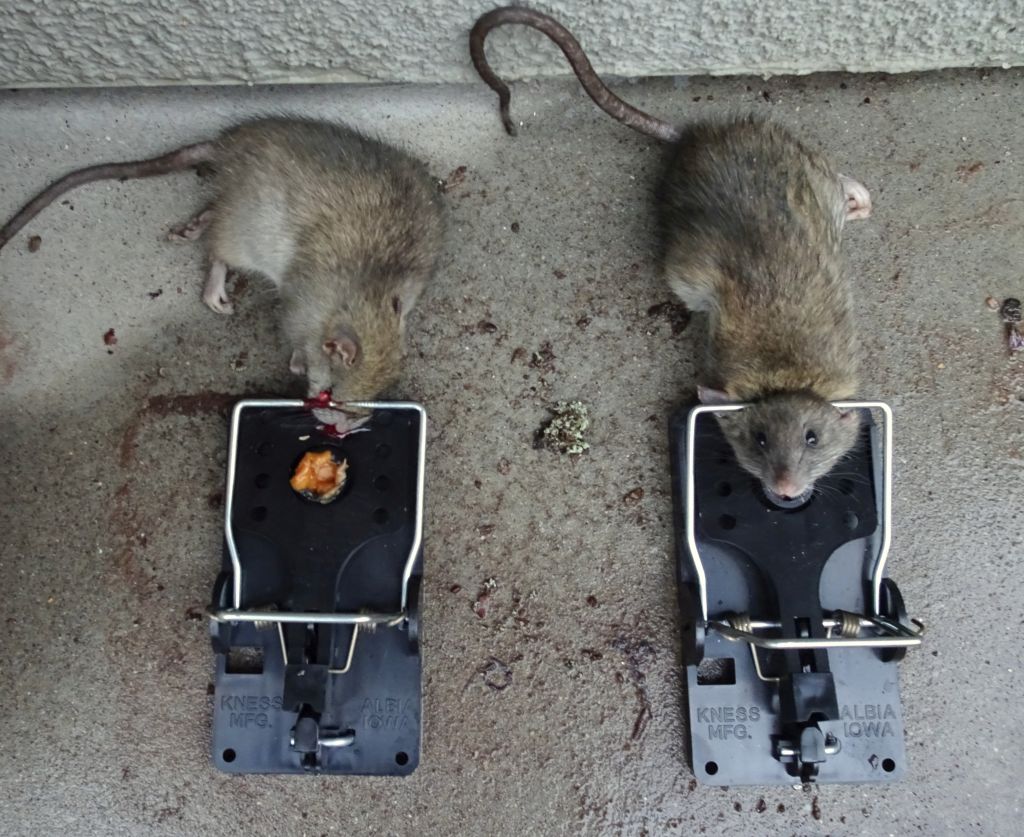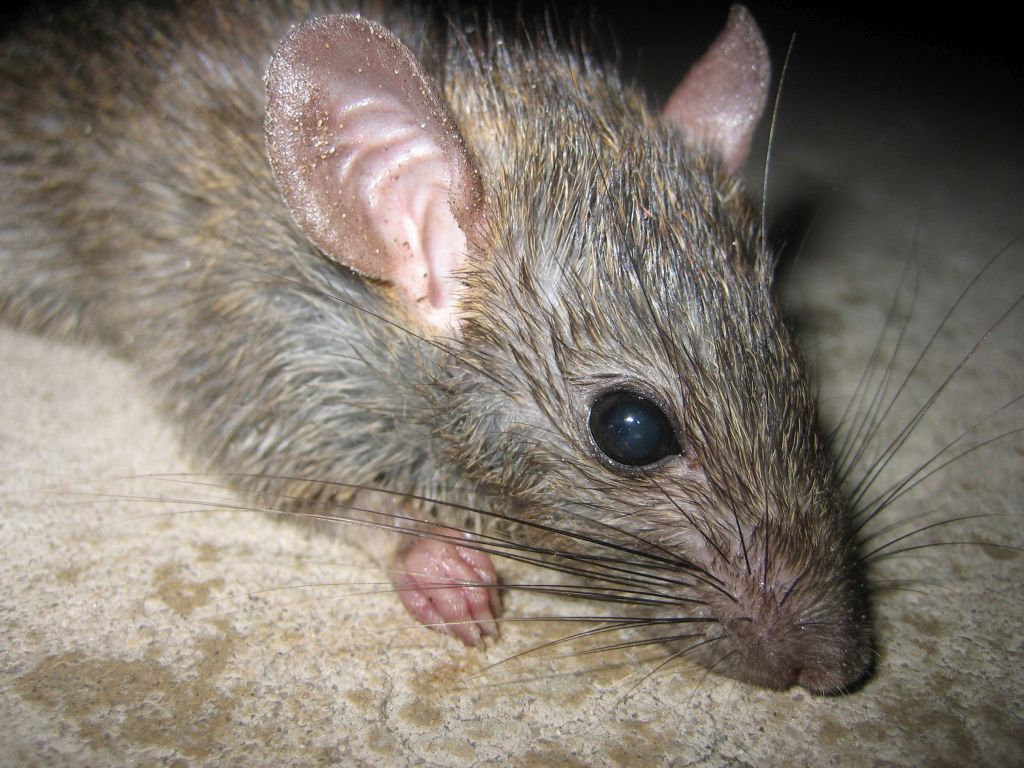Rats & Mice Control

Rat Removal
Rats are one of the most common household infestations, and you may be aware of DIY extermination methods like traps and chemical treatments. While these approaches may be effective on one or two rats, they can be dangerous, difficult to execute effectively, and won’t stand a chance against a larger rat infestation. In most cases, it’s a much better strategy to call in experts right away.

How rats enter residential spaces
There are two common species of rats in the United States: the Norway rat (Rattus norvegicus) and the roof rat (Rattus rattus). Norway rats are typically larger and nest closer to the ground, while roof rats are smaller and are often above ground on roofs or on trees or wires. Since rats are so small, they have countless opportunities for entry into your home, where they’ll then create nests and settle down. Even if there aren’t clear entry points into your home, rats have such sharp teeth that they can often gnaw their way through blockages to create a new opening.
Here are the most common signs to watch for that may indicate a rat infestation: droppings, evidence of chewing or gnawing, hearing movement or squeaking in walls (especially at night), seeing live or dead rats, smelling an unpleasant scent, noticing burrows in your yard or gardens, having mouse traps that have activated with no sign of a captured mouse, and seeing rat tracks.
For this reason, rat problems are common and difficult to get a handle on without expert help. In many cases, DIY solutions like traps only provide temporary relief without addressing the long-term problem.
The potential damage caused by rats
Rats can cause a variety of types of damage both inside and outside of your home. Due to their sharp teeth, they’re able to chew through surfaces and wires on your property, both of which often leave lasting damage. Rats have also been known to raid bird nests, leave unsanitary urine and droppings, and even contaminate pet food leading to sickness or disease in domesticated animals.
Notably, there is also a risk of damage caused by ill-prepared rat traps. Many people attempt to take care of rat problems alone and pose a risk to children and pets with improper bait or trap placement. Rat traps are powerful enough to cause serious injury to adults and even more serious injury to children and pets.

How to eliminate rats from your home
There are tons of options to eliminate rats from your home, including both lethal and nonlethal options. Our approach will differ depending on the specifics of your rat problem: what type of rat you’re dealing with, where they’re located, how many there are, and other factors. Depending on your situation, we’ll get rid of, exterminate, trap, and remove the rats from your home.
We’ll follow the removal by repairing any damage from the rats and safely and properly cleaning up any remaining rat droppings. When we’re done, you’ll want to monitor your home for any signs of reentry to ensure long-term success.
You can help to protect your home long-term by making your space less attractive and accessible to rats. You may want to trim trees back from your roofline, monitor any cracks or openings in your home and have them sealed as quickly as possible, and remove vines from any walls around your home. If you’ve attempted to take care of your rat problem yourself, make sure to dispose of any dead rats you may have captured in traps or using baits so that the smell doesn’t attract more rats.
Timeline, cost, and other factors
The timeline, cost, and effectiveness of this process depend on many factors, especially on how many rats are in your home. For a more specific appraisal of your situation, take advantage of our free on-site quotes, where we’ll be able to provide more accurate estimates for timeline, cost, and effectiveness. While we’re based in Salt Lake City and Park City, we currently serve clients across Utah, Wyoming, and Idaho. Give Complete Wildlife Removal a call today!

What attracts rats to my property?
Let’s be honest about it – nobody wants to wake up and discover there are rats living on their property. And yet, rats are probably the most common attic guest in the United States. In our experience at Complete Wildlife Removal, you need to figure out what’s attracting them to your property, in order to successfully exclude them and prevent future invasions.
Now, what you need to understand about rats is that, like most other creatures, they’re just looking for two things: warmth and shelter. Rats may have quite the reputation in the human world, but in fact, they’re fairly small, and not all that menacing in the animal world. So they need whatever protection they can get, which is why they like hanging out in human homes. That, and people also tend to be messier than they think, so there’s really a lot of food for rats to gnaw on.
So without further ado, let’s talk a bit about what’s attracting rats to your property…
Cracks, holes, etc.
Rats are known for being highly sneaky and flexible creatures, which is what makes them so resilient, in the end. So no matter how tiny the crack or hole in your foundation, wall, window structure, etc, – a rat is quite likely to sneak in through there. This is why we recommend regular check-ups and inspections of your property, either conducted by you or by a qualified professional (e.g. a wildlife removal expert).
When you do find a crack or hole, we recommend sealing it up as swiftly as possible with wire mesh (which is difficult to chew or claw through)
Food, leftovers, etc.
Another big draw for most rodents is, as we already mentioned, the food you already have in your house. See, one crucial mistake that most homeowners make is they assume they need to have really messy homes to attract a rat. But that’s not usually the case. Rats, being fairly small animals, are attracted to anything from leftovers to crumbs on the carpet, and it’s all too easy to disregard those. So in other words, we recommend running regular clean-ups and also storing your leftovers in difficult-to-open containers, so as to prevent animals from getting to them.
Water sources.
Like any other creature, rats need to drink as much as they need to eat. So they’ll also be more attracted to homes with a readily available water source, such as a leaky pipe. This is why we urge homeowners to check the condition of their pipes fairly regularly, to make sure that’s not what’s attracting rats.
Pet poo.
No, really. Rats aren’t all that picky when it comes to their food, so they’ve been known to be attracted by digested food, as much as any other kind. This means that if you’ve got pet poo lying around, it’s time to get rid of it because it might just be what’s attracting the rats to your home.
Warmth.
Lastly, rats are looking for a place to call home and it’s important to remember that. One of the main reasons why they love hanging out in people’s homes is that here, they enjoy more warmth and general comfort than in other, wild areas. Alas, there’s nothing you can do about the warmth – it’s not like you’re going to make your home cool and uninviting just on account of rats.
But we at Complete Wildlife Removal suggest that you keep an eye out for the other attraction points we mentioned above. By reducing these, you diminish the risk of waking up with a rat in your home!

How to Get Rats Out of The Attic?
Unfortunately, it’s not at all uncommon to learn there are rats living on your property. As human dwellings and urban areas continue to expand, wild animals are left with less natural habitats, and forced to adapt, and learn how to co-inhabit urban areas. This is why rats are probably the most common wild animal intruder on human properties across the United States.
At Complete Wildlife Control, we’ve seen a lot of pesky rodents down the years, and so we’ve compiled a list of things you can do to keep them out of your home, more specifically your attic. Rats, like many other wild animals, are attracted to attics since that’s the least inhabited area of your home. And since attics are also often used as storage spaces, they allow for plenty of room for rats to hide and build homes.
So what can you do to get rats out of your attic, and keep them out?
- Trim your tree branches.
It’s quite likely that the rats inside your attic are what we commonly call roof rats. This particular type of rodent is a naturally skilled climber, and it probably got into your attic through overgrown tree branches. This is why we always advise trimming your yard, and your trees, so as not to allow access to your roof.
Quite often, property owners are unaware of a hole, crack or missing shingle on their roof. But if a rat gets up there, this can be ample space for them to squeeze through, and get to warmth and safety (which is the main appeal of human homes). So it’s important to keep them from getting up there in the first place. But if they do get up there…
- Seal any holes and cracks.
Remember that rats are highly versatile and adaptable creatures. If they find a hole, no matter how small it may seem to you, they will find a way to get in, even if they have to chew or claw their way in. This is why it’s important to regularly inspect your roof and attic structure, and seal such potential entry points as soon as possible.
We also recommend that you use materials that are difficult or impossible to chew or claw through, like wire mesh, hardware cloth, or fitted foam, to seal these holes.
- Use a live trap.
The best, and most humane, option for getting rid of roof rats is using a live trap. Once you’ve identified the rat’s entry point, you’ll want to figure out its a natural path through the attic and set up your attic on this path. A live trap is basically a cage that will lure the rat inside (usually using something like peanut butter), and trap it inside, without actually harming it. Once trapped, you can use the live trap to relocate the rat to a place where it won’t bother you.
- Call a wildlife removal company.
If you’re unsure what to do to get rid of the rats in your attic, we urge you to call a wildlife removal professional. Not only will they remove the rat(s), but they will also advise you on future prevention, weaknesses, and clean and repair the mess caused by the rat (in some cases).
- Focus on prevention.
Once the rat is safely out of the home, we suggest you focus on prevention. Keep log piles and firewood away from the house, as these can provide a hiding place, and attract rats, as well as wild animals.
Regularly clean out your attic, to remove unnecessary objects and boxes that may provide hiding spots.

How to Keep Rats Out Of Your Garden
As a gardener, it’s terrible news to always find rats in your vegetable garden. Rats may wreak havoc on your fruits, veggies, seeds, bulbs, and plants, among other things. Rats can also spread diseases to humans and pets through bites, urine, and droppings, so if you have a rodent problem, you should take care of it right away.
If you suspect that you have rats, search for their nests and hideouts. Before you rule out a rat infestation, look beneath trash, logs, or brush piles, in drainages, underground, and in sheds, outhouses, or garages. The first sign of rodent infestations is usually droppings, if you have seen rat droppings more than a few times in your vegetable garden, chances are that you are dealing with an infestation.
Rat droppings are typically 15 to 20 mm long, cylindrical; flat on one end and pointed on the other end. The droppings are fresh if they are moist and shiny. If they’re dry, the rat must have created them within the last few hours. In this article, we’ll show you how to keep rats out of your garden.
Protect your compost bin
If you compost on a regular basis, make sure your compost bin has a strong, lockable cover that rodents cannot open. A compost bin without a sturdy lock will act as a safe haven for rodents, when rats gain entry to your compost, they will find plenty of food and invite their family to their new favorite spot. Rats can also be deterred by wrapping chicken wire around the foot of the compost container, but your best bet is a bin with a sturdy lock and impregnable by rodents. Another thing to be cautious of is what goes into the compost pit. It should be mainly vegetables, and waste from the garden, don’t include animal proteins in the compost as they will only attract pests like rats, mice, etc.
Store bird/pet food securely
Rats will most likely come to your garden because they are looking for food, and if you feed birds, this will give them a valid reason to always come around.
Rats find pet food and poultry feed very attractive, therefore endeavor to store your pet/bird food in very secure containers with a tight lids. The food you put out for birds should hang where rats cannot reach. And if there are grains falling off the feeders and lying around, promptly sweep them up to avoid rats from getting to them first. If you notice that feeding birds are contributing to the rat infestation in your garden, you may completely eliminate bird feeding to keep rodents away.
Keep your garden tidy
You can keep rats out by keeping your garden tidy. This is because rats are always looking for a conducive place where there is plenty of food and shelter, and an untidy vegetable garden with overgrown shrubs is more than perfect for them. Therefore, make an extra effort to keep grasses short, and also remove trash from your garden as frequently as possible. Cut down overgrowing plants and tall weeds, and remove clutter like piles of logs and or garden waste. Also make sure that there are no plants creeping from the garden to the walls of your building because this will only direct the rats to enter your home, which will make things worse. Finally, block access holes in garden buildings. Garden shelters and other outbuildings should be free of any gaps in the walls, floors, or doors. A metal kick plate installed at the foot of shed doors can also help.
How to Keep Rats out of Your Garbage Can?
If there are one nuisance animal species that are considered to be the most disease-ridden and destructive, it has to be the rat. Rats are found in virtually any environment and have become a staple in urban life, learning how to use human activity to their own ends. Often, this involves rats finding garbage and gorging on it. If rats are getting into your garbage, there may be bigger problems afoot that should be addressed. Continue reading to learn how to keep rats out of your garbage can.
What attracts rats to a property?
Rats, like virtually all nuisance animals, are attracted to homes and properties for two main reasons. The most obvious reason is easy access to food. Rats are always on the lookout for an easy food source, and they particularly love what they can find in the garbage can. Between the food scraps, humans throw out and any other edible things they can find in the trash, this is often how homeowners discover that rats are around their property. In addition to food, rats are also very keen to find any type of warm, dry shelter that they can. This often points them in the direction of homes, garages, and sheds.
What problems do rats cause?
Rats are one of the worst nuisance animals you can get, as they not only spread all kinds of disease but tear up homes and properties in the process. The most serious of these problems is the health hazards, as rats are capable of giving humans and pets a wide variety of terrible viral and bacterial infections that can potentially have fatal consequences. These diseases are spread through bites, scratches, coming into contact with rat feces, urine, or saliva, or by the areas that rats contaminate simply by touching them.
Rats are also highly destructive, wreaking havoc on attics of homes. Rats chew up electrical wiring, which can potentially cause fires. They gnaw through all kinds of structural materials including wood, drywall, and many others. These rodents tear up insulation, costing you more money on heating and cooling expenses. Finally, they can even create new entry holes to gain access to your attic and other parts of your home.
How can I keep rats out of my garbage can?
Preventing rats from getting access to your garbage can is a relatively straightforward process, as long as you have the proper garbage can. A simple way to do this is to have a garbage can that has “locks” that can be clamped down until you need to open it. Another idea is to use a bungee cord to strap the lid down. While keeping rats out of the garbage can might be simple, it does signify a bigger problem that you may have with rodents that should be looked at in more detail.
How should rats be removed?
If rats are getting into your garbage can, there is a chance that they may be in your home or garage as well. If you have any suspicion that there are rats in your home or on your property, you might consider hiring a professional wildlife removal service to come to examine your home and property, and remove any of the rodents that may be there. Not only will this keep rodents from your garbage, but it will keep them from endangering you, your family, and your pets. In addition to removing the rats, the experts will be able to find any weak points of your home or property and will be able to suggest solutions for each, keeping any future pest infestations from occurring.
Request Free Quote


